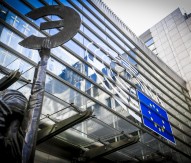
Connecting with chemistry
IN DEPTH: In an interview with Portal, SusChem innovation manager Dr Jacques Komornicki detailed the priorities of the European Technology Platform’s new strategic innovation and research agenda.
The direct and indirect contributions of Europe’s chemical industry account for around 20% of the EU’s annual GDP in terms of gross value added. The European chemistry industry works alongside nearly all value chains and across industrial sectors ranging from pharmaceuticals, crop protection, automotive, defence, construction, textiles, electronics and consumer goods. Chemistry also plays a pivotal role in supporting Europe 2020, the European Commission’s growth strategy to transform the Union into a smart, sustainable and inclusive economy.

Dr Jacques Komornicki
Established in 2004, the European Technology Platform (ETP) for Sustainable Chemistry (SusChem) is the voice of the chemical industry and its stakeholders, including research technology organisations, academia and governmental policy groups. The organisation provides input for the formulation of topics into the work programmes of Horizon 2020 and other EU initiatives. According to Dr Jacques Komornicki, innovation manager at SusChem, “industry doesn’t work in isolation”.
SusChem has three core missions namely “strategy (the main output of the ETP is to publish a strategic research agenda (SRA)); to mobilise members; and to disseminate its activities. SusChem also focuses on ensuring current technology priorities of the chemical industry are clearly communicated to the Commission and eventually represented in project calls.” This is the essence of the dialogue between the ETPs and the Commission.
New agenda
In March, SusChem announced the publication of a new strategic innovation and research agenda (SIRA), which sets out the innovation priorities for the ETP in the short and medium term. The new document highlights the role of the chemical industry in boosting innovation in Europe and the potential for sustainable chemistry technologies to tackle the Societal Challenges outlined in the EU’s research and innovation framework programme.
The SIRA also explains the strategy and role of SusChem in the context of Europe 2020, and highlights a portfolio of sustainable chemistry R&I actions that the platform believes can make a significant contribution to improving competitiveness and sustainability in the EU, address societal challenges, and contribute to achieving jobs and inclusive growth.
The new SIRA introduces major changes from the past SRA by addressing new topics such as ICT and manufacturing, and new business models, as well as promoting collaboration along the value chains in the domains of the bioeconomy, energy, mobility and health. It also outlines the crucial links between SusChem’s priorities and the Key Enabling Technologies (KET) that Europe is both pushing forward and investing in. The KETs are: biotechnology, nanotechnology, advanced materials, advanced manufacturing and processing, micro- electronics and nano-electronics, and photonics.
Announcing the SIRA, which was also debated at the SusChem stakeholder event in June 2014, Dr Klaus Sommer, chairman of the SusChem board, said: “Everything we do should be focused on ultimately improving societal conditions, in particular with respect to sustainability – working for ‘people, planet and profit’. Our work will be fully justified if we can simultaneously create jobs, improve the environment and generate greater economic success and wellbeing.
“In this spirit, the new SIRA is a great opportunity for SusChem and sustainable chemistry research and innovation across Europe. The SIRA will add value to the societal, scientific and industrial debate and help us to focus on the real challenges we face.”
To discuss the SIRA in greater detail, as well as SusChem’s contribution to Horizon 2020 and the importance of SMEs, Portal spoke to Komornicki, who began by outlining the new R&I roadmap.
What are the main changes introduced in the new SIRA?
Industry has been organised through the ETP to have a dialogue with the EU on its research and innovation agenda. Considering the existing technology priorities of industry, ten years since the publication of the first SIRA, and a move more towards innovation, it was important to update the content. In particular with Horizon 2020, there is a movement from research to innovation that is even more industry driven. With this in mind, SusChem decided there was a need to publish a new agenda to redefine and rephrase our strategy regarding research and innovation in Europe’s chemical industry.
Instead of talking about technologies, what we have decided to do in the new SIRA is define how we see the societal challenges of Europe and the solutions we are working on. This therefore means that there is a good alignment between our SIRA and the Societal Challenges that have been defined by the EU.
SusChem covers five Societal Challenges, namely climate action, the bioeconomy, energy, health, and transport. In addition, there are cross-cutting KETs which are not directly connected to one challenge but can be used to address different challenges. We are focusing on the KETs because sustainable chemistry deals with four of these enabling technologies.
This brings about a very good alignment with Horizon 2020 and the Societal Challenges that were defined in Europe 2020. On top of that, we have seen a new area that will become more important in the future: the contribution of ICT to the chemical industry. Consequently in the SIRA, we have a special chapter which focuses on how ICT will assist the chemical industry moving forward.
To what extent have you received a positive reaction from your stakeholders to the SIRA?
Last year we discussed the new SIRA with our stakeholders and we validated all the chapters and topics. This year we talked about how to implement the agenda and identify the main values of the SIRA; this was the topic of our stakeholder event in June, which saw discussions on the barriers that we need to overcome.
One of the main overarching goals in Europe is to create economic growth and jobs, and we know that the SMEs play a big role in this. SMEs are very important to SusChem and one of the main problems they have is gaining access to large companies. Therefore, this year we held a special event allowing innovative SMEs to pitch to the big companies.
The SMEs involved have innovative technologies within SusChem’s areas of interests. We need to identify these innovative technologies and how we can deliver them. To help encourage the participation of SMEs in Horizon 2020, SusChem is also releasing an SME funding guidance kit.
How would you assess the development of Horizon 2020 so far?
Innovation is an important priority to Europe, from the highest political level to the implementation of calls under Horizon 2020. Many of the framework programme’s calls reflect SusChem’s priorities, and we see chemical companies really participating in the calls.
SusChem contributed to the content of the work programmes for Horizon 2020, and based on the 2014-2015 work programmes, we undertook an analysis of how the content fits with SusChem’s priorities. We subsequently identified about 100 topics that were connected to our areas of interest, and these results are a good sign that we have some influence on the European agenda.
We also assessed the participation of the big companies of the European Chemical Industry Council involved in Horizon 2020, and found they have been participating and submitting many proposals. There has been a reasonable success rate in getting projects funded, although the competition is tough. We have been successful in mobilising the core community to participate in the calls, which is important because having an agenda that is effective without participating would be meaningless.
How do you assess the progress made by Horizon 2020 in encouraging the greater participation of industry and SMEs?
If we consider the data published by the EU on the 2014 PPP calls and the projects that are receiving funding, we can see that there is good participation from SMEs. In addition, there is specific funding directed to SMEs, which has also had a good uptake.
Yet with greater participation, the success rate can be lower compared to the number of small and medium-sized businesses that applied. However, participation has so far been really good and SMEs are becoming more and more involved.
To what extent is there enough emphasis on crossing the ‘valley of death’ in Horizon 2020?
In the Industrial Leadership pillar, there are specific calls relating to pilot activities based on the technology readiness level. In addition, there is the ‘Fast Track to Innovation’ pilot, a special tool that is open permanently where a company can submit proposals on an idea that will go to the market quickly. These activities show the EU is giving a lot of importance to bringing ideas and innovation to the market.
Furthermore, among the calls connected to the Societal Challenges there are also calls relating to the demonstrations of pilots. This is one of the differences between Horizon 2020 and the Seventh Framework Programme. In addition, the Juncker Investment Plan includes the idea that innovation could be developed with some combined funding schemes.
How is SusChem contributing to the development of the next stages of Horizon 2020’s work programmes?
We have a permanent dialogue with the Commission, especially with DG Research and Innovation, and when we see an issue or something we want to bring to the attention of the EU institution, we have direct contact and discuss the issues involved. Also discussed are the new trends in industry and in the market.
We constantly talk to the Commission about different issues, for example CO2 capture and use or specific technology topics, e.g. lightweight materials, which are particularly important for the transportation sector. Consequently, we are contributing to the 2016-2017 work programmes and beyond as we will continue this communicative relationship.
How can the chemical industry contribute to the circular economy?
There are a couple of topics, for example CO2 utilisation and recyclable lightweight materials or the waste to resources concept. We are also drawing attention to one aspect of the circular economy: inside the loop, we can optimise the use of resources before they make their way to the consumer – this is an industry to industry effort known as ‘industrial symbiosis’. This can be a big contributor to the circular economy and is the ‘invisible part of the iceberg’ because action is taken before moving to the consumer.
Dr Jacques Komornicki
This article is also published in the seventh edition of Portal, which is now available to read online.




